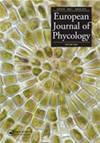浮游硅藻属Bacteriatrum(硅藻门)六种的生物地理学
IF 1.7
4区 生物学
Q2 MARINE & FRESHWATER BIOLOGY
引用次数: 3
摘要
摘要海洋浮游硅藻物种可以表现出不同的分布模式,从地方性到世界性。鉴于浮游物种潜在的庞大种群规模和通过洋流的充足迁徙机会,其特有性与直觉相悖。在这里,我们分析了六种硅藻属细菌的生物地理学,其分布模式明显不同。从海洋采样日(OSD)站点和塔拉海洋站的样本中的metabarcode读取获得的发生率数据,以及从GBIF和OBIS生物多样性数据库中的观测记录中获得的发生度数据绘制在发生率图中。根据代谢条形码数据,这里检查的六个物种分布在海洋的温带和热带地区。观测记录证实了B.elegans、B.furcatum、B.hyalinum和B.mediteraneum的这一发现。相反,非典型的殖民地前贾德拉姆B.jadranum只在几个遥远的地方出现,而孤立的平行B.parallelum只在那不勒斯湾出现。代谢条形码数据显示,根据GBIF和OBIS,后两个物种的分布远比它们实际看到的要广泛,透明B.hyalinum也出现在北极。不同数据来源之间存在差异的最可能原因是对B.jadranum和B.parallelum的描述相对较新,它们的体型较小且不明显,以及它们在常规浮游生物计数中可能存在的误认。亮点•Tara Oceans和OSD的Metabarcoding数据可识别细菌种类。•根据全球代谢编码数据,细菌属物种的泛洋分布。•浮游植物物种的分布模式可以从全球代谢条形码数据集中推断出来。本文章由计算机程序翻译,如有差异,请以英文原文为准。
Biogeography of six species in the planktonic diatom genus Bacteriastrum (Bacillariophyta)
ABSTRACT Marine planktonic diatom species can exhibit contrasting distribution patterns, from endemic to cosmopolitan. Endemicity is counter-intuitive for planktonic species given their potentially large population sizes and ample migration opportunities by means of ocean currents. Here, we analyse the biogeography of six species of the diatom genus Bacteriastrum with apparently contrasting distribution patterns. Occurrence data obtained from metabarcode reads in samples from Ocean Sampling Day (OSD) sites and from Tara Oceans stations as well as from their observational records included in biodiversity data repositories of GBIF and OBIS were plotted in occurrence maps. According to metabarcoding data, the six species examined here occur all over the temperate and tropical parts of the oceans. Observational records corroborate this finding for B. elegans, B. furcatum, B. hyalinum and B. mediterraneum. Instead, atypical colony former B. jadranum is encountered at just a few distant sites, and solitary B. parallelum only in the Gulf of Naples. The metabarcoding data reveal that the latter two species are far more widely distributed than their actual sightings according to GBIF and OBIS, and that B. hyalinum also occurs in the Arctic. The most likely reasons for the discrepancies among the different data sources are the relatively recent description of B. jadranum and B. parallelum, their diminutive and inconspicuous habitus, and their possible misidentification in routine plankton counting. HIGHLIGHTS • Metabarcoding data of Tara Oceans and OSD discern Bacteriastrum species.• Pan-oceanic distribution of Bacteriastrum species according to global metabarcoding data.• Distribution patterns of phytoplankton species can be inferred from global metabarcode datasets.
求助全文
通过发布文献求助,成功后即可免费获取论文全文。
去求助
来源期刊

European Journal of Phycology
生物-海洋与淡水生物学
CiteScore
4.80
自引率
4.20%
发文量
37
审稿时长
>12 weeks
期刊介绍:
The European Journal of Phycology is an important focus for the activities of algal researchers all over the world. The Editors-in-Chief are assisted by an international team of Associate Editors who are experts in the following fields: macroalgal ecology, microalgal ecology, physiology and biochemistry, cell biology, molecular biology, macroalgal and microalgal systematics, applied phycology and biotechnology. The European Journal of Phycology publishes papers on all aspects of algae, including cyanobacteria. Articles may be in the form of primary research papers and reviews of topical subjects.
The journal publishes high quality research and is well cited, with a consistently good Impact Factor.
 求助内容:
求助内容: 应助结果提醒方式:
应助结果提醒方式:


